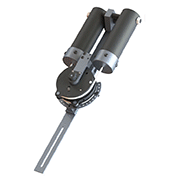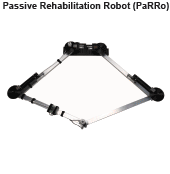Design and Preliminary Assessment of a Passive Elastic Leg Exoskeleton for Resistive Gait Rehabilitation
https://www.embs.org/tbme/wp-content/uploads/sites/19/2021/05/TBME-01036-2020-Highlight-Image.gif
170
177
IEEE Transactions on Biomedical Engineering (TBME)
//www.embs.org/tbme/wp-content/uploads/sites/19/2022/06/ieee-tbme-logo2x.png
While devices that assist walking can enable individuals with neuromusculoskeletal impairments, recovery is often better facilitated by devices that resist walking. Moreover, current robotic interfaces for gait rehabilitation are typically huge, bulky, and come with a large price tag. This article describes the design and development of a novel, wearable, passive elastic exoskeleton for resistive gait rehabilitation. The system uses counteracting compressional springs, pulleys, and clutches and can be configured to resist flexion, extension, or bidirectionally. Thus, the device can target user-specific muscle weaknesses and accommodate range of motion limitations. These concepts were validated using benchtop and human subject experiments.
read more


